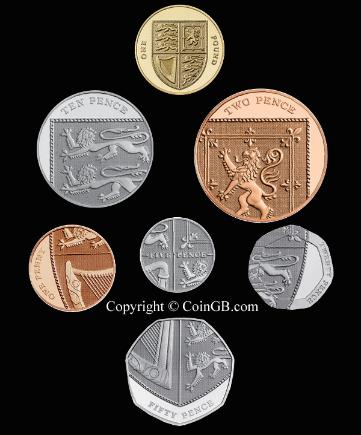Currently the money used in the UK is called British pence (or penny) which has the "p" sign after
the amount and Pounds Sterling, the sign for the pound is £.
There are 100 pennies in 1 pound. This new measurement or standard for money was introduced
in 1971 and was called decimalisation.
The coins used are one pence, two pence, five pence, ten pence, twenty pence, fifty pence, one
pound and two pound coins.
For example someone might say I have £5 (five pounds) in my pocket or I only have 58p (fifty
eight "Pee" or pence) in my pocket.
the amount and Pounds Sterling, the sign for the pound is £.
There are 100 pennies in 1 pound. This new measurement or standard for money was introduced
in 1971 and was called decimalisation.
The coins used are one pence, two pence, five pence, ten pence, twenty pence, fifty pence, one
pound and two pound coins.
For example someone might say I have £5 (five pounds) in my pocket or I only have 58p (fifty
eight "Pee" or pence) in my pocket.


In 2008 the Royal Mint released a new design for UK coins from 1 pence up to and including the
£1 coin. To come up with the new design the Royal Mint launched a nationwide competition and
the Matt Dent with his "shield" design. The shield is that of the Royal arms.
Above you can see the reverse of each coin from the penny up to and including the pound coin.
The pound coin shows the full shield design and the other denominations have parts of the shield
designs on them, when laid out in a certain way the make up the majority of the shield design as
can be seen on the picture below.
£1 coin. To come up with the new design the Royal Mint launched a nationwide competition and
the Matt Dent with his "shield" design. The shield is that of the Royal arms.
Above you can see the reverse of each coin from the penny up to and including the pound coin.
The pound coin shows the full shield design and the other denominations have parts of the shield
designs on them, when laid out in a certain way the make up the majority of the shield design as
can be seen on the picture below.
1 pence 2pence 5 pence 20 pence 50 pence 1 pound

The obverse of the newly designed coins feature a more up to date bust of Queen Elizabeth II with
the legend ELIZABETH II D.G. REG. F. D and the date, which stands for Elizabeth II, By the Grace
of God Queen and Defender of the Faith.
the legend ELIZABETH II D.G. REG. F. D and the date, which stands for Elizabeth II, By the Grace
of God Queen and Defender of the Faith.

Although all the sizes and weights of the types of coins are standard, there are many different
designs for each type of coin. The Royal Mint often produces new designs to mark new occasions
(like the 2012 London Olympics) as well as anniversaries.
Below are some different types of 50 pence coins that can be found circulating or in your change.
designs for each type of coin. The Royal Mint often produces new designs to mark new occasions
(like the 2012 London Olympics) as well as anniversaries.
Below are some different types of 50 pence coins that can be found circulating or in your change.

The circulating UK two pound (£2) coin is a bi-metalic coin. That means it is made from two
different types of metal. The inner circle is a silver colour (composition = 75% Cu , 25% Ni) and
the outer ring is a gold/brass (composition = 76% Cu, 20% Zn and 4% Ni) colour. The two pound
coin comes in many different varieties (types).
It has a diameter of 28.4 mm and weighs 12 grams
Below you can see just one example of a two pound coin.
different types of metal. The inner circle is a silver colour (composition = 75% Cu , 25% Ni) and
the outer ring is a gold/brass (composition = 76% Cu, 20% Zn and 4% Ni) colour. The two pound
coin comes in many different varieties (types).
It has a diameter of 28.4 mm and weighs 12 grams
Below you can see just one example of a two pound coin.

UK Currency
UK Banknotes
The main banknotes found circulating in the UK are five pounds (£5), ten pounds (£10), twenty
pounds (£20) and the fifty pounds (£50) banknotes. Different banks produce their own notes and
they will appear different but each one will have the value of the note on it. Some Scottish banks
also issue a one pound (£1) banknote. Notes from Scotland and Northern Ireland aren't strictly
"legal tender" in England. Bank of England notes are only legal tender in England and Wales,
however most shops and people will accept notes from other counties within the UK.
Below are pictures £5, £10, £20 and £50 banknotes issued by the Bank of England.
pounds (£20) and the fifty pounds (£50) banknotes. Different banks produce their own notes and
they will appear different but each one will have the value of the note on it. Some Scottish banks
also issue a one pound (£1) banknote. Notes from Scotland and Northern Ireland aren't strictly
"legal tender" in England. Bank of England notes are only legal tender in England and Wales,
however most shops and people will accept notes from other counties within the UK.
Below are pictures £5, £10, £20 and £50 banknotes issued by the Bank of England.
